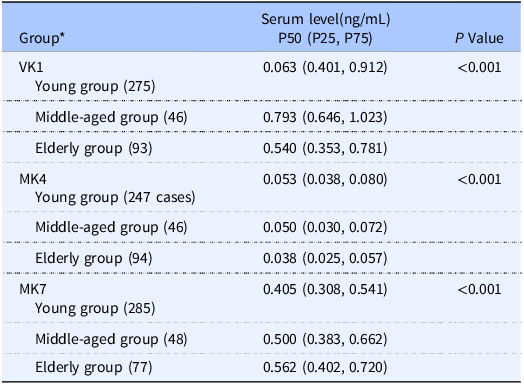

The level of serum MK7 showed a significant upward trend with increase of age (P < 0.001).
The findings demonstrated statistically significant differences in serum VK1, MK4, and MK7 levels across the young, middle-aged, and elderly age groups. In contrast, within each age group, no significant disparities were observed between male and female subgroups. Consequently, this study utilised age-based categorization to establish reference intervals for VK1, MK4, and MK7.
The reference intervals for MK7 established in this study, both the lower and upper limits, were significantly lower than the average concentrations reported in Japanese women of different age groups (4.96, 8.42, and 4.21 ng/mL), which is closely related to the widespread consumption of vitamin K-rich natto in Japan. The lower limit of the MK7 reference interval established in this study is lower than the normal adult reference interval reported in Italy (0.33–4.48 ng/mL), with nearly 94% of the detected values below the mean of 0.85 ng/mL reported for women of reproductive age in domestic studies, yet the lower limit of our reference interval is close to the lower bound of the established reference interval of 0.12–3.54 ng/mL.
Therefore, the lower bounds of the reference intervals established in this study, except for MK4, are close to those in domestic and international related studies. The differences in the high values of the upper limits are closely related to individual differences in the study population, as well as regional and dietary nutritional status. This also suggests that different regions and individuals have a relatively consistent tolerance to vitamin K deficiency, but have a higher tolerance for different serum concentrations and high doses of VK.
Why would MK7 increase with age in healthy people?

